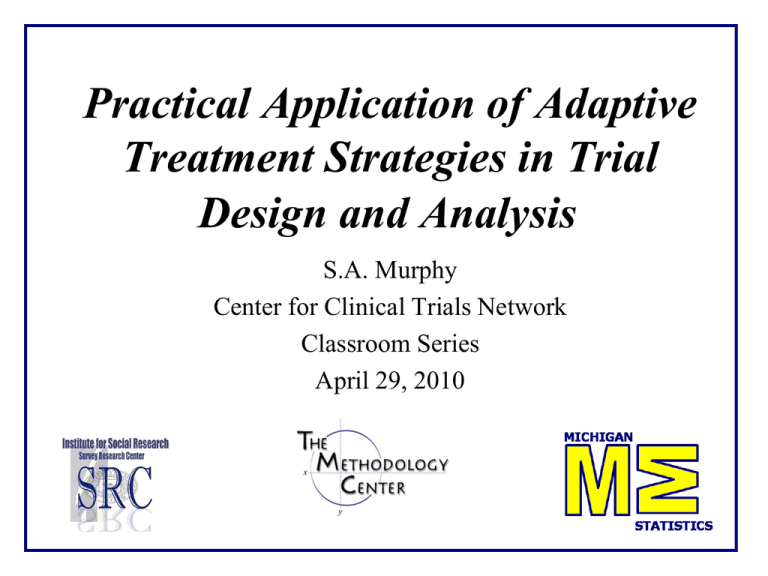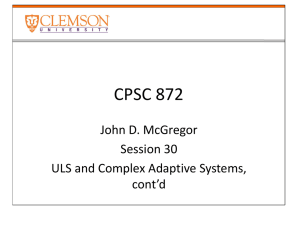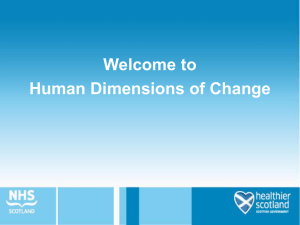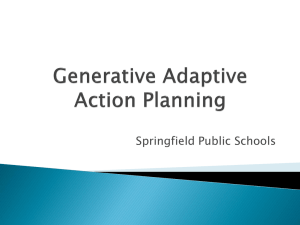CTN04.10
advertisement

Practical Application of Adaptive Treatment Strategies in Trial Design and Analysis S.A. Murphy Center for Clinical Trials Network Classroom Series April 29, 2010 Outline • Why Adaptive Treatment Strategies? – “new” treatment design • Why SMART experimental designs? – “new” clinical trial design • Trial Design Principles and Analysis • Examples of SMART Studies • Discussion Adaptive Treatment Strategies are individually tailored treatments, with treatment type and dosage changing according to patient outcomes. Operationalize clinical practice. •Brooner et al. (2002, 2007) Treatment of Opioid Addiction •McKay (2009) Treatment of Substance Use Disorders •Marlowe et al. (2008) Drug Court •Rush et al. (2003) Treatment of Depression Why Adaptive Treatment Strategies? – High heterogeneity in response to any one treatment • What works for one person may not work for another • What works now for a person may not work later – Improvement often marred by relapse – Lack of adherence or excessive burden is common – Intervals during which more intense treatment is required alternate with intervals in which less treatment is sufficient 4 Why not combine all possible efficacious therapies and provide all of these to patient now and in the future? •Treatment incurs side effects and substantial burden, particularly over longer time periods. •Problems with adherence: •Variations of treatment or different delivery mechanisms may increase adherence •Excessive treatment may lead to non-adherence •Treatment is costly (Would like to devote additional resources to patients with more severe problems) More is not always better! 5 Example of an Adaptive Treatment Strategy •Adaptive Drug Court Program for drug abusing offenders. •Goal is to minimize recidivism and drug use. •Marlowe et al. (2008) Adaptive Drug Court Program non-responsive low risk As-needed court hearings + standard counseling As-needed court hearings + ICM non-compliant high risk non-responsive Bi-weekly court hearings + standard counseling Bi-weekly court hearings + ICM non-compliant Court-determined disposition 7 The Big Questions •What is the best sequencing of treatments? •What is the best timings of alterations in treatments? •What information do we use to make these decisions? (how do we personalize the sequence of treatments?) Outline • Why Adaptive Treatment Strategies? – “new” treatment design • Why SMART experimental designs? – “new” clinical trial design • Trial Design Principles and Analysis • Examples of SMART Studies • Discussion Why SMART Trials? What is a sequential multiple assignment randomized trial (SMART)? These are multi-stage trials; each stage corresponds to a critical decision and a randomization takes place at each critical decision. Goal is to inform the construction of adaptive treatment strategies. Sequential Multiple Assignment Randomization Initial T xt Intermediate Outcome Secondary T xt Relapse Early Responder R Prevention Low-level Monitoring Switch to Tx C Tx A Nonresponder R Augment with Tx D R Early Responder Relapse R Prevention Low-level Monitoring Tx B Switch to Tx C Nonresponder R Augment with Tx D One Adaptive Treatment Strategy Initial T xt Intermediate Outcome Secondary T xt Relapse Early Responder R Prevention Low-level Monitoring Switch to Tx C Tx A Nonresponder R Augment with Tx D R Early Responder Relapse R Prevention Low-level Monitoring Tx B Switch to Tx C Nonresponder R Augment with Alternate Approach to Constructing an Adaptive Treatment Strategy • Why not use data from multiple trials to construct the adaptive treatment strategy? • Choose the best initial treatment on the basis of a randomized trial of initial treatments and choose the best secondary treatment on the basis of a randomized trial of secondary treatments. Delayed Therapeutic Effects Why not use data from multiple trials to construct the adaptive treatment strategy? Positive synergies: Treatment A may not appear best initially but may have enhanced long term effectiveness when followed by a particular maintenance treatment. Treatment A may lay the foundation for an enhanced effect of particular subsequent treatments. Delayed Therapeutic Effects Why not use data from multiple trials to construct the adaptive treatment strategy? Negative synergies: Treatment A may produce a higher proportion of responders but also result in side effects that reduce the variety of subsequent treatments for those that do not respond. Or the burden imposed by treatment A may be sufficiently high so that nonresponders are less likely to adhere to subsequent treatments. Prescriptive Effects Why not use data from multiple trials to construct the adaptive treatment strategy? Treatment A may not produce as high a proportion of responders as treatment B but treatment A may elicit symptoms that allow you to better match the subsequent treatment to the patient and thus achieve improved response to the sequence of treatments as compared to initial treatment B. Selection Effects Why not use data from multiple trials to construct the adaptive treatment strategy? Subjects who will enroll in, who remain in or who are adherent in the trial of the initial treatments may be quite different from the subjects in SMART. Summary: •When evaluating and comparing initial treatments, in a sequence of treatments, we need to take into account, e.g. control, the effects of the secondary treatments thus SMART •Standard one-stage randomized trials may yield information about different populations from SMART trials. Sequential Multiple Assignment Randomization Initial T xt Intermediate Outcome Secondary T xt Relapse Early Responder R Prevention Low-level Monitoring Switch to Tx C Tx A Nonresponder R Augment with Tx D R Early Responder Relapse R Prevention Low-level Monitoring Tx B Switch to Tx C Nonresponder R Augment with Tx D Examples of “SMART” designs: •CATIE (2001) Treatment of Psychosis in Schizophrenia •STAR*D (2003) Treatment of Depression •Pelham (primary analysis) Treatment of ADHD •Oslin (primary analysis) Treatment of Alcohol Dependence •Jones (in field) Treatment for Pregnant Women who are Drug Dependent •Kasari (in field) Treatment of Children with Autism Outline • Why Adaptive Treatment Strategies? – “new” treatment design • Why SMART experimental designs? – “new” clinical trial design • Trial Design Principles and Analysis • Examples of SMART Studies • Discussion SMART Design Principles •KEEP IT SIMPLE: At each stage (critical decision point), restrict class of treatments only by ethical, feasibility or strong scientific considerations. Use a low dimension summary (responder status) instead of all intermediate outcomes (adherence, etc.) to restrict class of next treatments. •Collect intermediate outcomes that might be useful in ascertaining for whom each treatment works best; information that might enter into the adaptive treatment strategy. SMART Design Principles •Choose primary hypotheses that are both scientifically important and aids in developing the adaptive treatment strategy. •Power trial to address these hypotheses. •Choose secondary hypotheses that further develop the adaptive treatment strategy and use the randomization to eliminate confounding. •Trial is not necessarily powered to address these hypotheses. SMART Designing Principles: Primary Hypothesis •EXAMPLE 1: (sample size is highly constrained): Hypothesize that controlling for the secondary treatments, the initial treatment A results in lower symptoms than the initial treatment B. •EXAMPLE 2: (sample size is less constrained): Hypothesize that among non-responders a switch to treatment C results in lower symptoms than an augment with treatment D. EXAMPLE 1 Initial T xt Intermediate Outcome Secondary T xt Relapse Early Responder Prevention Low-level Monitoring Switch to Tx C Tx A Nonresponder Augment with Tx D Early Relapse Responder Prevention Low-level Monitoring Tx B Switch to Tx C Nonresponder Augment with Tx D EXAMPLE 2 Initial T xt Intermediate Outcome Secondary T xt Relapse Early Responder Prevention Low-level Monitoring Switch to Tx C Tx A Nonresponder Augment with Tx D Early Relapse Responder Prevention Low-level Monitoring Tx B Switch to Tx C Nonresponder Augment with Tx D SMART Designing Principles: Sample Size Formula •EXAMPLE 1: (sample size is highly constrained): Hypothesize that given the secondary treatments provided, the initial treatment A results in lower symptoms than the initial treatment B. Sample size formula is same as for a two group comparison. •EXAMPLE 2: (sample size is less constrained): Hypothesize that among non-responders a switch to treatment C results in lower symptoms than an augment with treatment D. Sample size formula is same as a two group comparison of non-responders. Sample Sizes N=trial size Example 1 Δμ/σ =.3 N = 402 Δμ/σ =.5 N = 146 α = .05, Example 2 N = 402/initial nonresponse rate N = 146/initial nonresponse rate power =1 – β=.85 An analysis that is less useful in the development of adaptive treatment strategies: Decide whether treatment A is better than treatment B by comparing intermediate outcomes (proportion of early responders). 29 SMART Designing Principles •Choose secondary hypotheses that further develop the adaptive treatment strategy and use the randomization to eliminate confounding. •EXAMPLE: Hypothesize that non-adhering nonresponders will exhibit lower symptoms if their treatment is augmented with D as compared to an switch to treatment C (e.g. augment D includes motivational interviewing). EXAMPLE 2 Initial T xt Intermediate Outcome Secondary T xt Relapse Early Responder Prevention Low-level Monitoring Switch to Tx C Tx A Nonresponder Augment with Tx D Early Relapse Responder Prevention Low-level Monitoring Tx B Switch to Tx C Nonresponder Augment with Tx D Outline • Why Adaptive Treatment Strategies? – “new” treatment design • Why SMART experimental designs? – “new” clinical trial design • Design Principles and Analysis • Examples of SMART Studies • Discussion 32 Jones’ Study for Drug-Addicted Pregnant Women rRBT 2 wks Response Random assignment: tRBT Random assignment: tRBT tRBT Nonresponse eRBT Random assignment: 2 wks Response aRBT Random assignment: rRBT rRBT Random assignment: Nonresponse tRBT rRBT Oslin ExTENd Naltrexone 8 wks Response Random assignment: Early Trigger for Nonresponse Random assignment: TDM + Naltrexone CBI Nonresponse CBI +Naltrexone Random assignment: 8 wks Response Naltrexone Random assignment: TDM + Naltrexone Late Trigger for Nonresponse Random assignment: Nonresponse CBI CBI +Naltrexone Kasari Autism Study JAE+EMT Yes 12 weeks A. JAE+ EMT AssessAdequate response? JAE+EMT+++ Random assignment: No JAE+AAC Random assignment: Yes 12 weeks B. JAE + AAC B!. JAE+AAC AssessAdequate response? No B2. JAE +AAC ++ 35 Pellman ADHD Study A1. Continue, reassess monthly; randomize if deteriorate Yes 8 weeks A. Begin low-intensity behavior modification A2. Add medication; bemod remains stable but medication dose may vary AssessAdequate response? No Random assignment: Random assignment: A3. Increase intensity of bemod with adaptive modifications based on impairment B1. Continue, reassess monthly; randomize if deteriorate 8 weeks B. Begin low dose medication AssessAdequate response? No Random assignment: B2. Increase dose of medication with monthly changes as needed B3. Add behavioral treatment; medication dose remains stable but intensity of bemod may increase with adaptive modifications based on impairment Discussion • Secondary analyses can use pretreatment variables and outcomes to provide evidence for a more sophisticated adaptive treatment strategy are coming out soon. (when and for whom?) • We have a sample size formula that specifies the sample size necessary to detect an adaptive treatment strategy that results in a mean outcome δ standard deviations better than the other strategies with 90% probability (A. Oetting, J. Levy & R. Weiss are collaborators) • Aside: Non-adherence is an outcome (like side effects) that indicates need to tailor treatment. 37 SMART Designing Principles: Primary Hypothesis •EXAMPLE 3: (sample size is less constrained): Hypothesize that adaptive treatment strategy 1 (in blue) results in improved symptoms as compared to strategy 2 (in red) EXAMPLE 2 Initial Txt Intermediate Outcome Secondary Txt Relapse Early Responder Prevention Low-level Monitoring Switch to Tx C Tx A Nonresponder Augment with Tx D Early Relapse Responder Prevention Low-level Monitoring Tx B Switch to Tx C Nonresponder Augment with Tx D 39






